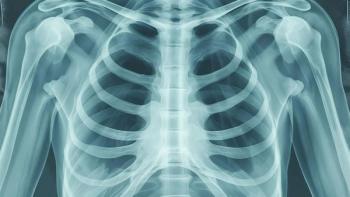
Enhertu Linked to Sustained Survival Benefit in Gastroesophageal, Gastric Cancer Subset
The use of Enhertu was associated with a reduction in the risk of death compared with standard chemotherapy in certain patients with gastroesophageal and gastric cancer.
Patients with HER2-positive gastric cancer or gastroesophageal junction (GEJ) adenocarcinoma achieved a 40% reduction in the risk of death after receiving treatment with Enhertu (fam-trastuzumab deruxtecan-nxki) compared with standard chemotherapy, according to newly release data.
Updated study results from the phase 2 DESTINY-Gastric01 trial — which were presented during the 2022 American Society of Clinical Oncology Gastrointestinal Cancer Symposium — showed that Enhertu continued to induce a median overall survival (the time from the start of treatment when a patient with cancer is still alive) of 12.5 months compared with 8.9 months in those who received chemotherapy.
“With continued follow-up after the primary analysis, (Enhertu) demonstrated a clinically meaningful (overall survival) benefit and clinically relevant improvement in (objective response rate) compared with standard chemotherapy in HER2-positive advanced gastric or GEJ cancer,” lead study author Kensei Yamaguchi, of The Cancer Institute Hospital of the Japanese Foundation for Cancer Research in Tokyo, said in a presentation during the meeting.
In January 2021, the
The agency based its decision on primary findings from the phase 2 DESTINY-Gastric01 study, which showed that the median overall survival with Enhertu was 12.5 months compared with 8.4 months with irinotecan or paclitaxel in this patient population.
The study authors evaluated Enhertu versus physician’s choice of standard chemotherapy in patients with HER2-expressing advanced gastric or GEJ adenocarcinoma who had received at least two prior regimens, including fluoropyrimidine, a platinum-based agent, and Herceptin or an approved biosimilar.
Patients who had or were suspected to have interstitial lung disease (a group of disorders associated with scarring of lung tissue) or pneumonitis, or a history of noninfectious interstitial lung disease or pneumonitis that had been treated with steroids, were excluded from enrollment.
Patients either received Enhertu at 6.4 mg/kg every three weeks (126 patients) or chemotherapy with irinotecan or paclitaxel (62 patients). Eighty-six percent of participants received a prior taxane, 71% had been treated with Cyramza (ramucirumab), and 31% received prior PD-1/PD-L1 inhibitors.
Measuring the objective response rate, which is the percentage of patients with partial and complete responses to the treatment, was the main goal of the study. Other goals included assessing overall survival rates, duration of treatment response, safety and progression-free survival (the time after treatment until disease progresses).
Patients enrolled onto the trial had received either two (57.1%), three (28.1%), or at least four (14.9%) prior systemic therapies, which consisted of Herceptin (100%), Cyramza (70.7%), taxane (86.4%), irinotecan or another topoisomerase I inhibitor (7.3%), or an immune checkpoint inhibitor (31.3%). Patients in the Enhertu group were more than twice as likely to have received four or more prior therapies.
Additional data with the longer follow-up which were presented at this meeting showed that treatment with Enhertu was associated with a confirmed objective response rate of 42% compared with 12.5% with chemotherapy. Moreover, 8.4% and 33.6% of patients who received the study drug achieved a complete and partial response, respectively. Three patients (2.5%) were not evaluable for response.
The confirmed disease control rate was 85.7% with Enhertu compared with 62.5% with chemotherapy. The updated results also showed that the confirmed median duration of response was 12.5 months and 3.9 months, respectively. The median time to response was similar between treatment groups, at 1.5 months with Enhertu and 1.6 months with chemotherapy.
“This presentation shows that most patients (who) received (Enhertu) had a reduction in tumor size compared with approximately half of patients receiving (chemotherapy),” Yamaguchi said.
In terms of safety, serious or severe side effects occurred in 85.6% of patients receiving Enhertu compared with 56.5% of those receiving chemotherapy.
Sixteen patients experienced interstitial lung disease/pneumonitis related to treatment with Enhertu. These incidents occurred at levels of severity, most of which were considered minor.
The median time to first onset of interstitial lung disease/pneumonitis among the 16 individuals was 102.5 days (range, 36 to 638).
There was one treatment-related death from pneumonia in the group that received study drug, which was already reported in the primary analysis.
“This additional follow-up provides further evidence that (Enhertu) is an effective treatment option for patients with HER2-positive advanced gastric cancer or GEJ adenocarcinoma who have progressed after two or more previous lines of therapy, including (Herceptin), fluoropyrimidine, and a platinum agent,” Yamaguchi concluded.
For more news on cancer updates, research and education, don’t forget to




